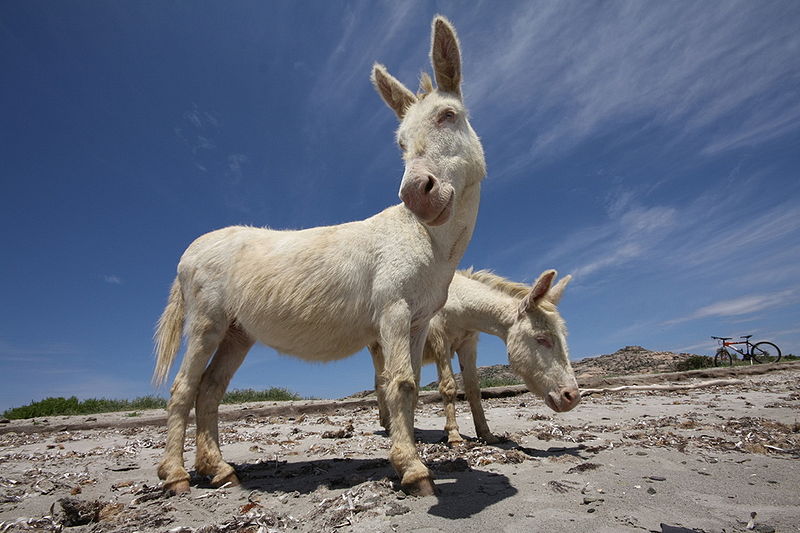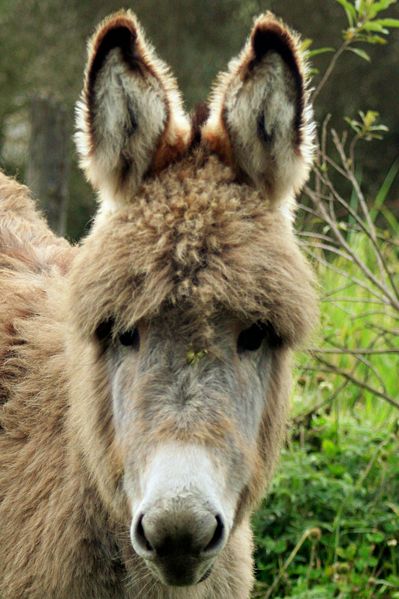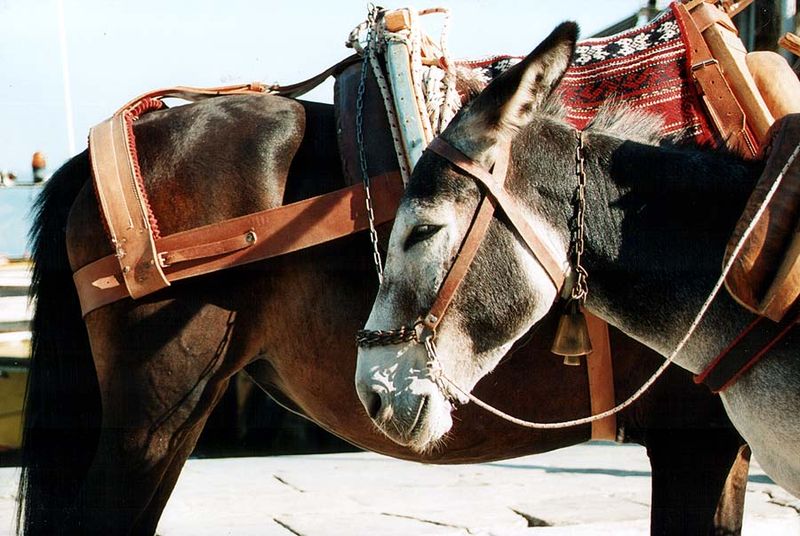Donkeys and Asses are often mentioned in the pages of history books and in numerous pages of the Holy Scriptures.
Baudet de Poitou
The Baudet de Poitou is a unique-looking mammal. It is also known by various common names such as the Poitou Ass, the Poitou Donkey, the Poitevin Donkey, and the Mammoth Donkey. It is a peculiar breed of donkey that originates in the Poitou region of France. This creature is among the rarest and least-known. The "friendly, affectionate and docile" Poitou Donkey is "the oldest breed approved in France"
Albino Donkey (Equus asinus var. albina)
All albinos, whether human or any species of animal is unique, one of them is the Albino Donkey or White Donkey. In Italian, it is called Asinello Bianco or Asino Albino. This unique breed of donkey is native to the island of Asinara, Sardinia. The habitat of this rare variant of Equus asinus is restricted to the Island of Asinara. At present, the total population is estimated about 90 individuals.
African Wild Ass (Equus africanus)
The African Wild Ass is a wild member of the horse family, Equidae. This handsome-looking species is believed to be the ancestor of the Domestic Donkey. These creatures inhabit the desert and other arid areas of Africa, Eritrea, Ethiopia and Somalia. It is estimated that there are about 570 individuals that exist in the wild.
Somali Wild Ass (Equus africanus somaliensis)
Somali Wild Ass, which resembles the African Wild Ass, is a subspecies found in the Southern Red Sea region of Eritrea, Ethiopia and Somalia. The legs of the Somali wild ass are horizontally striped with black, resembling those of a zebra. At present, there are about 150 individuals that live in zoos in the different parts of the world.
Wooly Paramo Donkey
Another endangered species of donkey is the Woolly Paramo Donkey. It can be found in high elevations of up to 3,000 m altitude and the permanent snow line of about 5,000 meters. It can be found in Colombia.
Balkan Donkey
Balkan Donkeys are endangered species. This domestic breed of donkey originated in the Balkans, hence their common name. These very rare donkeys numbering about 100 in Zasavica Reserve, Sremska Mitrovica in Serbia, produced the most expensive cheese in the world – the Pule Cheese.
Andalusia Donkey
Andalusia Donkey is another endangered species. This donkley breed is endemic to Cordoba in Andalusia, Spain. It is also called "Donkey of Lucena Breed". This breed is considered the oldest of the European breeds, with some 3,000 years.
Catalan Donkey (Equus asinus)
The Catalan Donkey or Ruc Catala is the local donkey of Catalonia in Spain. There are about 50,000 Catalan Donkeys before but these days there are only about 500 left. It is regarded as the “best donkey in the world” after winning several shows and contests.
Provence Donkey
Provence Donkeys are unique breed that originated from the Basse-Provence, Haute-Provence and Dauphine regions of France. It was developed by shepherds to aid them in their sheep tending duties and seasonal migrations between grazing areas. It is also known as the 'Migration Donkey', the 'Aries Donkey', the 'Crau Donkey' and the 'Savoie Donkey’. In 1993 there were only 330 recorded Provence donkeys left.
See also
- Europe’s Beautiful But Endangered Species
- Critically Endangered Animal Species of Asia and Australia
- North and South America’s Most Endangered Species
- The Most EndangeredAnimal Species of Africa
- World’s Smallest and Largest Endangered Species Endemic to the Philippine
- Only in the Philippines:Endemic and Rare Animals
- Colorful,Unique and Rare But Threatened Philippine Birds
- World’s Smallest and Largest Endangered Species Endemic to the Philippines
- Living and Extinct Animals With Tusks
- Extinct and Extant: World’s Largest Crocodiles and Lizards Ever
- The World’s Largest Extinct and Extant Flying Creatures Ever












ReplyDeleteDonkey animal pictures free photos download
Hello! There isn't actually an endangered species of donkey known as the Woolly Paramo Donkey. The linked image is from the wikipedia about Paramo, and the Páramo woolly donkey is not a subspecies, but rather a descriptive name for donkeys that live in the high Andes and have a heavy coat (according to the publisher of the image you used from wikipedia, whom I emailed). He said they are not a native páramo species, and there is no info available anywhere about them being endangered (though, woolly donkeys in that area may be rare!)
ReplyDelete